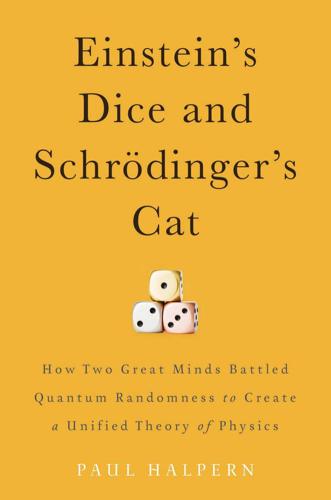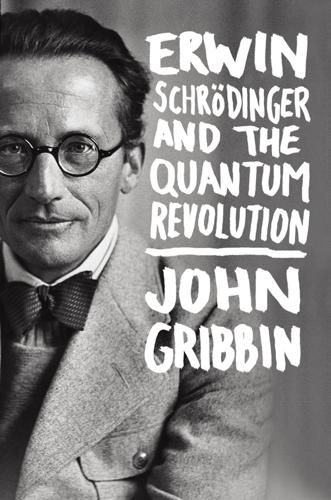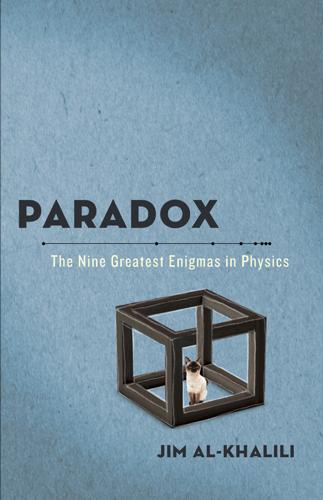
Einstein's Dice and Schrödinger's Cat: How Two Great Minds Battled Quantum Randomness to Create a Unified Theory of Physics
by
Paul Halpern
Published 13 Apr 2015
Perhaps it was time, puzzled readers may have thought, to get to know Schrödinger better. 2 Introduction: Allies and Adversaries A Gruesome Conundrum Today, what comes to mind for most people who have heard of Schrödinger are a cat, a box, and a paradox. His famous thought experiment, published as part of a 1935 paper, “The Present Situation in Quantum Mechanics,” is one of the most gruesome devised in the history of science. Hearing about it for the first time is bound to trigger gasps of horror, followed by relief that it is just a hypothetical experiment that presumably has never been attempted on an actual feline subject. Schrödinger proposed the thought experiment in 1935 as part of a paper that investigated the ramifications of entanglement in quantum physics.
…
In no way, shape, or form would Bohr consider Einstein’s (and later Schrödinger’s) quest for a unified field theory credible, as the models Einstein advanced weren’t based on atomic data and didn’t even reckon with nuclear forces. Nevertheless, Bohr was always polite and patient, even with his detractors. Schrödinger’s kitty conundrum was published in November 1935 as part of a paper, “On the Present Situation in Quantum Mechanics”— the same article in which he had coined the term “entanglement.” As we discussed in the introduction, the thought experiment was scarcely known by the public until many decades later. At that point, only the physics community had the opportunity to laugh, shriek, or grumble at Schrödinger’s bizarre hypothetical scenario.
…
See also Strong nuclear forces; Weak nuclear forces Nuclear theory, 136 Pais, Abraham, 96, 107 Parallel postulate, 19, 20, 21 Parity conservation, 216 Particle accelerators, 227 Particle physics, 71 Paschen series, 48 Pathfinder (journal), 197 Patriotic Front (Austria), 144 Pauli, Wolfgang, 11, 83, 84–85, 86, 105, 130, 148, 149 criticism of distant parallelism, 116 criticism of Einstein’s unified theory, 187–188 exclusion principle, 95, 209 feud with Heisenberg, 216–217 as information source for physicists, 101, 112 as mediator between Einstein and Schrödinger, 197 proof of Schrödinger equation, 98 tribute to Einstein, 213 work with Einstein on fivedimensional unification model, 170–171 Pauli matrices, 146 Pernet, Jean, 30 “A Philosopher Looks at Quantum Mechanics” (Putnam), 4 Photoelectric effect, 33, 34–35, 90 Photons, 35, 47, 93 Old quantum theory, 48 Olympia Academy, 34 “On the Perceptible Content of Quantum Theoretical Kinematics and Mechanics” (Heisenberg), 105 O’Nolan, Brian, 9, 163–165, 198 “On the Conduction of Electricity on the Surface of Insulators in Moist Air” (Schrödinger), 25–26 “On the Method of Theoretical Physics” (lecture), 69 “On the Present Situation in Quantum Mechanics” (Schrödinger), 142 OPERA (Oscillation Project with Emulsion-tRacking Apparatus), 234–235 Operational Epsilon, 179–180 Oppenheimer, J. Robert, 169, 196, 200, 206 O’Rahilly, F., 163–164 265 Index Princeton University Press, 203–205, 220 Princip, Gavrilo, 51 Probability waves, 100 Protons, 146–147, 227 Prussian Academy of Sciences Einstein and, 56, 58, 104, 125, 128 Schrödinger and, 7, 92, 119, 128 Psi function, 97.

Erwin Schrodinger and the Quantum Revolution
by
John Gribbin
Published 1 Mar 2012
Through no art of interpretation can this ψ-function be turned into an adequate description of a real state of affairs . . . in reality there is just no intermediary between exploded and not-exploded. Stimulated by the EPR paper and his correspondence with Einstein, Schrödinger wrote a long paper, published in three parts in the journal Die Naturwissenschaften later in 1935, summing up his understanding of the theory he had helped to invent. It was titled “The Present Situation in Quantum Mechanics,” and it introduced to the world both the term “entanglement” and the cat “paradox,” which (like the EPR “paradox”) is not really a paradox at all. An excellent English translation of the paper, by John Trimmer, appeared in the Proceedings of the American Philosophical Society in 1980, and can also be found in the volume edited by Wheeler and Zurek, Quantum Theory and Measurement.
…
Bitbol); letter to Synge on quantum mechanics; Meine Weltansicht (My View of the World); Mind and Matter; “On the Conduction of Electricity on the Surface of Insulators in Moist Air”; “On Determinism and Free Will”; “On the Reversal of Natural Laws” paper (1931); papers (1914–15); papers (1917); papers (1920); papers (1922); papers (1922–6); papers (1926); papers (1930, 1931); paper (1939); poetry; “The Present Situation in Quantum Mechanics”; Space–Time Structure; Statistical Thermodynamics; “An Undulatory Theory of the Mechanics of Atoms and Molecules”; “The Visual Sensations”; What Is Life?; “What Is Real?” Schrödinger, Georgine (Georgie, née Bauer, mother): birth; death; family background; funeral; health; holiday in England; home in Vienna; marriage Schrödinger, Josef (grandfather) Schrödinger, Maria (grandmother) Schrödinger, Marie (aunt) Schrödinger, Rudolf (father): birth; career; death; family background; finances; health; influence on son; life in Vienna; marriage Schrödinger’s Kittens (Gribbin) Schrödinger’s Philosophy of Quantum Mechanics (Bitbol) Schulhof, Alfred Schuschnigg, Kurt Science Scientific American Soddy, Frederick Solvay, Ernest Solvay Congress: (1924); (1927); (1933); (1948) Sommerfeld, Arnold Space–Time–Matter (Weyl) spectroscopy spin “spooky action at a distance,” see action at a distance Stalin, Joseph Stanford Linear Accelerator Center (SLAC) statistical approach: Bell’s work; Boltzmann’s work; Born’s work; Bose–Einstein statistics; Copenhagen Interpretation; Einstein’s work; Fermi–Dirac statistics; Heisenberg’s work; Maxwell’s work; Planck’s work; quantum statistics; Schrödinger’s work statistical mechanics Stefan, Josef Stefan–Boltzmann Law Stuttgart “substitution” superposition Synge, John Tarner Lectures teleportation thermodynamics: Boltzmann’s work; Loschmidt’s work; Maxwell’s work; Planck’s work; Rudolph’s work; Schrödinger’s work; second law; statistical; Stefan’s work Thirring, Hans Thomson, J.

Paradox: The Nine Greatest Enigmas in Physics
by
Jim Al-Khalili
Published 22 Oct 2012
In 1935 one of the founders of quantum mechanics, the Austrian genius Erwin Schrödinger, had had enough of the weird interpretations of its mathematics. Following lengthy discussions with, among others, Albert Einstein himself, he proposed one of the most famous thought experiments in the history of science. He wrote a lengthy paper entitled “The Present Situation in Quantum Mechanics,” which was published in a leading German scientific journal. It has since become known simply as the “Schrödingers cat paper,” and it is incredible how many people, quantum physicists included, have since tied themselves up in knots trying to emphasize or explain away the supposed paradox Schrödinger described in it.

Super Thinking: The Big Book of Mental Models
by
Gabriel Weinberg
and
Lauren McCann
Published 17 Jun 2019
., not in the physical world. The most famous thought experiment is probably “Schrödinger’s cat,” named after Austrian physicist Erwin Schrödinger, who thought it up in 1935 to explore the implications of different interpretations of the physics of quantum mechanics. From his 1935 paper “The Present Situation in Quantum Mechanics”: A cat is penned up in a steel chamber, along with the following device (which must be secured against direct interference by the cat): in a Geiger counter, there is a tiny bit of radioactive substance, so small, that perhaps in the course of the hour one of the atoms decays, but also, with equal probability, perhaps none; if it happens, the counter tube discharges and through a relay releases a hammer that shatters a small flask of hydrocyanic acid.

Understanding Sponsored Search: Core Elements of Keyword Advertising
by
Jim Jansen
Published 25 Jul 2011
In the next chapter, we look at possible changes to sponsored search and the drivers of these changes. References ╇ [1] Popper, K. 1972. Objective Knowledge: An Evolutionary Approach. Oxford: Oxford University Press. ╇ [2] ErwinSchrödinger (Translated by John D. Trimmer). 1980. “The Present Situation in Quantum Mechanics: A Translation of Schrödinger ‘Cat Paradox Paper’.” Proceedings of the American Philosophical Society, vol. 124(1), pp. 323–338. ╇ [3] vonBertalanffy, L. 1976 [1956]. General System Theory: Foundations, Development, Applications. New York: Braziller. ╇ [4] Hart, M. H. 1992. The 100: A Ranking of the Most Influential Persons in History.